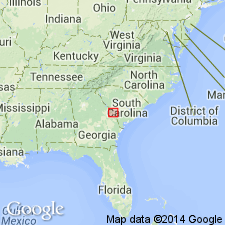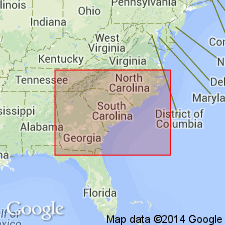
- Usage in publication:
-
- Tinker Creek Formation
- Modifications:
-
- Named
- Dominant lithology:
-
- Sand
- Silt
- Clay
- AAPG geologic province:
-
- Atlantic Coast basin
Summary:
Tinker Creek, a new formation in Barnwell Co., SC, consists of quartz sands, silts, and clays, which occur updip from the Santee Limestone. Thickness in type well is 33 ft. Yellow, tan, and white sands are common and pale green sands occur in the center of the site. Clay beds and laminae are more abundant in the Tinker Creek than in the underlying Warley Hill Formation or the overlying Orangeburg District bed or Blue Bluff unit. Burrows of OPHIOMORPHA abundant in some outcrops. Though very fine and fine sands are typical, medium and coarse sands are common. Tinker Creek sediments have been previously assigned by some workers to the Huber, the McBean, the Aiken, or the Neeses Formation. It is the informal "Tims Branch" of Fallaw and others (1992). Zone NP 16 (middle Eocene, middle Claibornian) indicated by a few palynomorph assemblages and PTEROPSELLA LAPIDOSA. Correlates with the Lisbon Formation, in part, of the Gulf Coast. Probably deposited in barrier, shallow marine, and lagoonal environments.
Source: GNU records (USGS DDS-6; Reston GNULEX).

- Usage in publication:
-
- Tinker Formation
- Modifications:
-
- Principal reference
- Revised
- AAPG geologic province:
-
- Atlantic Coast basin
Summary:
Tinker Creek Formation of Fallaw and Price (1992) is here formally renamed Tinker Formation. Unit is renamed to better distinguish it from the Tinkers Creek Formation in OH. Definition of unit is identical to that detailed in Fallaw and Price (1992). Overlies Warley Hill Formation; underlies Orangeburg District bed. Grades into Santee Limestone and Blue Bluff unit. Age is middle Eocene.
Source: GNU records (USGS DDS-6; Reston GNULEX).
For more information, please contact Nancy Stamm, Geologic Names Committee Secretary.
Asterisk (*) indicates published by U.S. Geological Survey authors.
"No current usage" (†) implies that a name has been abandoned or has fallen into disuse. Former usage and, if known, replacement name given in parentheses ( ).
Slash (/) indicates name conflicts with nomenclatural guidelines (CSN, 1933; ACSN, 1961, 1970; NACSN, 1983, 2005, 2021). May be explained within brackets ([ ]).

